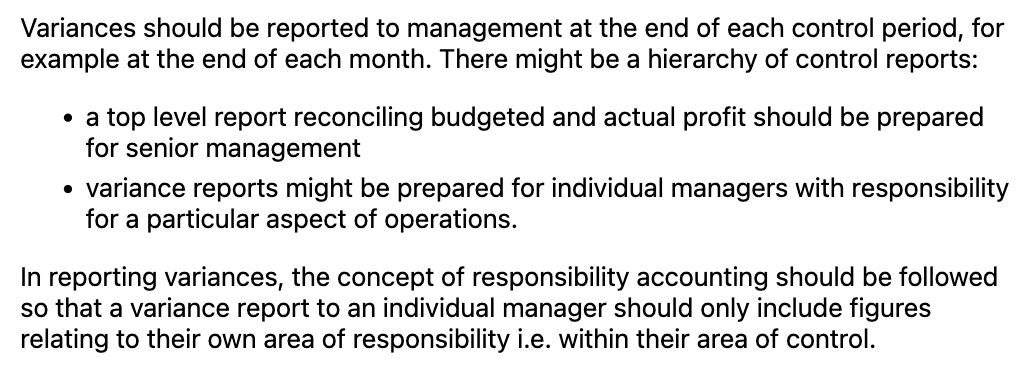Chapter 5: Variance analysis
1/40
There's no tags or description
Looks like no tags are added yet.
Name | Mastery | Learn | Test | Matching | Spaced |
|---|
No study sessions yet.
41 Terms
The following cards test the summary of variances sheet, theory will follow.
Sales Variance
What are the 3 key calculations for sales variances and when compared, what do the variances show?
Sales
Actual quantity sold * Actual price
Actual quantity sold * Standard price
Budgeted quantity sold * Standard price
1 vs 2 = Price variance
2 vs 3 = Volume variance
1 vs 3 = Total variance
Materials Variance
What are the 3 (there is an extra calculation for the 3rd) key calculations for materials variances and when compared, what do the variances show?
Materials
Actual quantity purchased * Actual price
Actual quantity purchased * Standard price
Standard quantity * Standard price
Standard quantity = Actual units * Standard kg/unit
1 vs 2 = Price variance
2 vs 3 = Usage variance
1 vs 3 = Total variance
How is closing inventory calculated?
Actual quantity purchased * Standard price
Actual quantity used * Standard price
Difference between 1 and 2 = closing inventory
Labour Variance
What are the 4 (there is an extra calculation for the 4th) key calculations for labour variances and when compared, what do the variances show?
Labour
Actual hours paid * Actual rate
Actual hours paid * Standard rate
Actual hours worked * Standard rate
Standard hours * Standard rate
Standard hours = Actual units * Standard hours/unit
1 vs 2 = Price/rate variance
2 vs 3 = Idle time variance
3 vs 4 = Efficiency variance
1 vs 4 = Total variance
Variable Overheads Variance
What are the 3 (there is an extra calculation for the 3rd) key calculations for variable overheads variances and when compared, what do the variances show?
Variable Overheads
Actual hours worked * Actual rate
Actual hours worked * Standard rate
Standard hours * Standard rate
Standard hours = Actual units * Standard hours/unit
1 vs 2 = Expenditure variance
2 vs 3 = Efficiency variance
1 vs 3 = Total variance
How is fixed overheads expenditure variance calculated under marginal costing?
Actual fixed overheads
Budgeted fixed overheads
Difference between 1 and 2 = expenditure variance
Fixed Overhead Variances under Absorption Costing
Units:
What are the 3 key calculations for fixed overheads variances (units) under absorption costing and when compared, what do the variances show?
Units
Actual fixed overheads
Budgeted units * Standard FOAR/unit
Actual units * Standard FOAR/unit
1 vs 2 = Expenditure variance
2 vs 3 = Volume variance
Hours:
What are the 4 key calculations for fixed overheads variances (hours) under absorption costing and when compared, what do the variances show?
Hours
Actual fixed overheads
Budgeted hours * Standard FOAR/hr
Actual hours * Standard FOAR/hr
Standard hours * Standard FOAR/hr
1 vs 2 = Expenditure variance
2 vs 3 = Capacity variance
3 vs 4 = Efficiency variance
Define standard costs (predetermined)

Define ‘standard price’.

Describe the 4 main types of standard:
Attainable standard
Basic standard
Current standard
Ideal standard
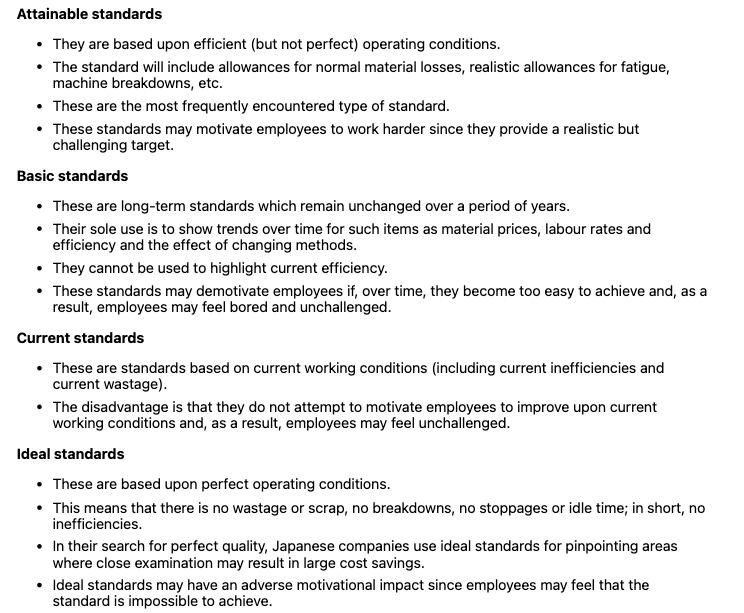
Elaborate on some of the following criticisms of the appropriateness of standard costing:
Standard costing was developed when business environments were more stable.
Attainment of the standard used to be judged as satisfactory.
Emphasis on labour variances.
Many modern products are digital.
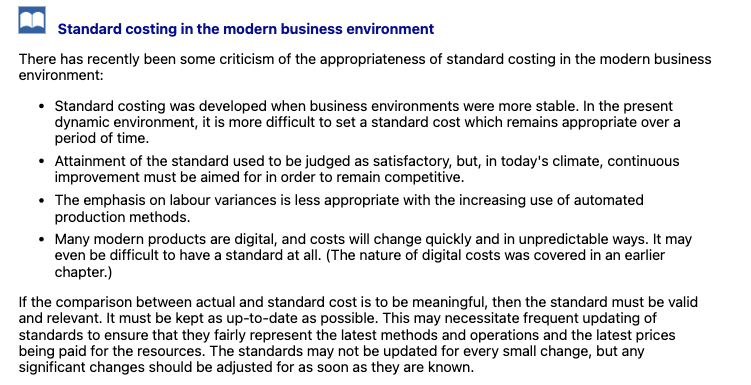
What is variance analysis?

Explain the difference between cost variances and sales variances

When do favourable and adverse variances occur?

What are the 3 main variance groups? What variances come under variable cost variances?
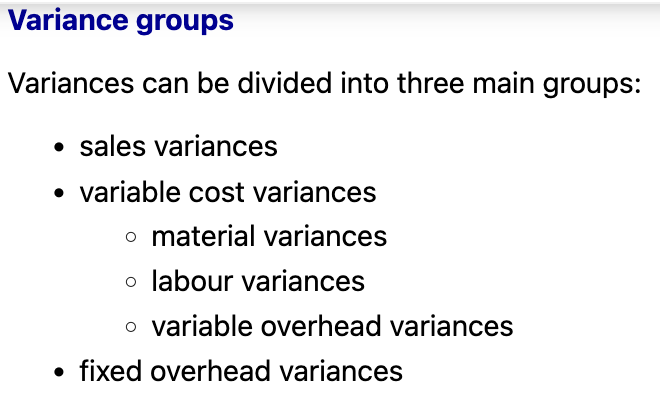
What effect does the sales price variance show?

What is sales volume variance a measure of?

What are some potential causes of sales price variances?
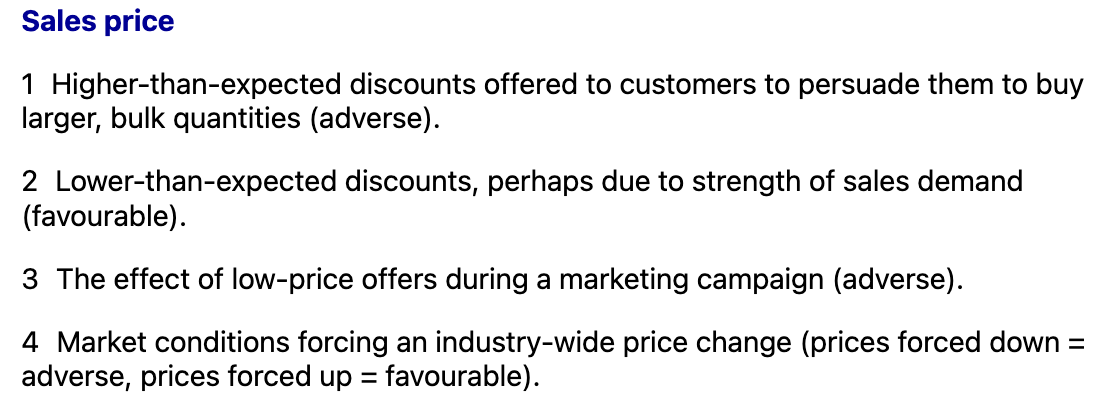
What are some potential causes of sales volume variances?
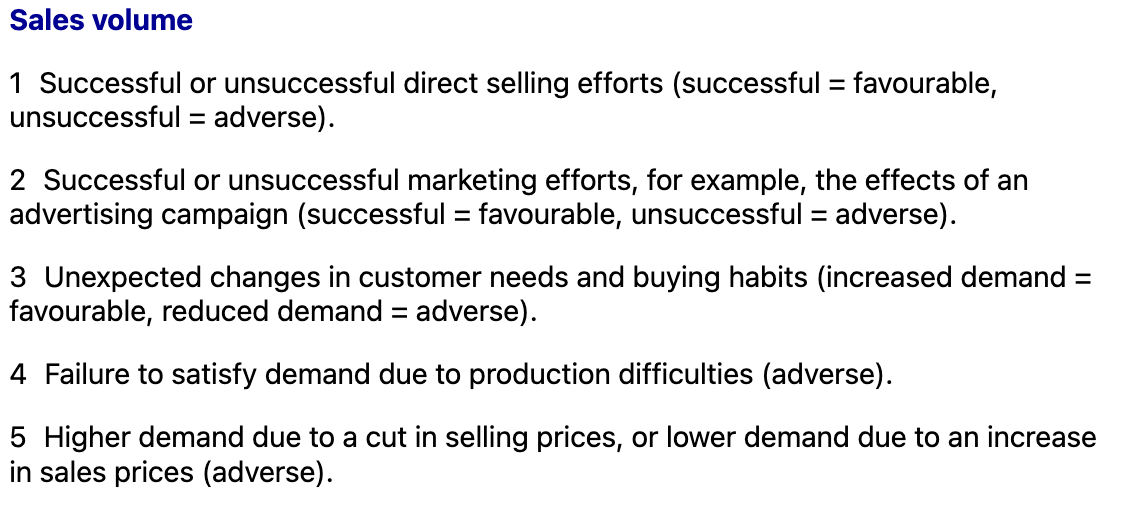
What is direct material total variance the difference between?

A total material variance actually conveys very little useful information. It needs to be analysed further. It can be analysed into two sub-variances:
Direct material price variance
Direct material usage variance
Define them
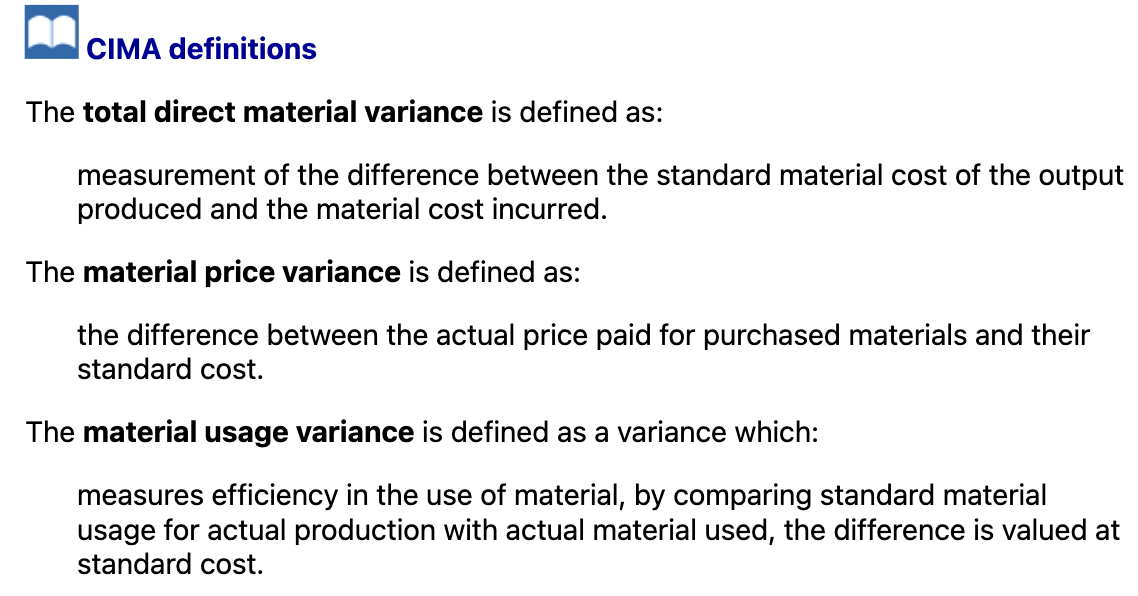
What is direct material price variance the difference between?
What happens if raw materials are valued at standard cost or actual cost?
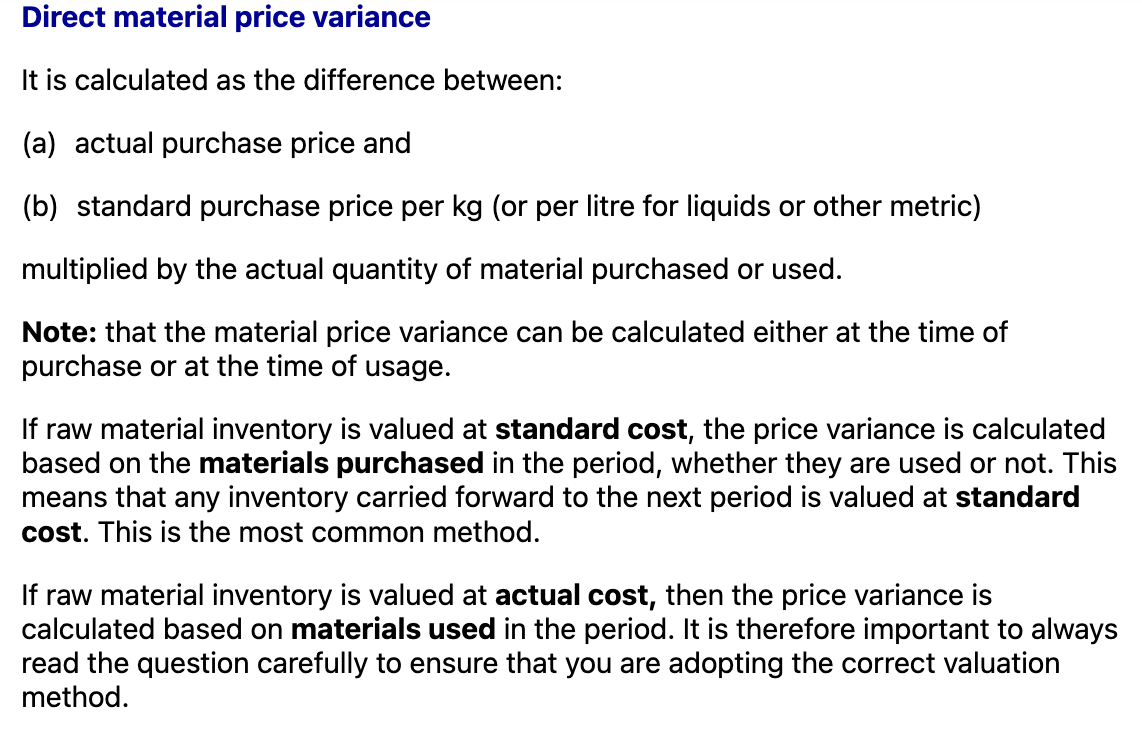
What does direct material usage variance show?
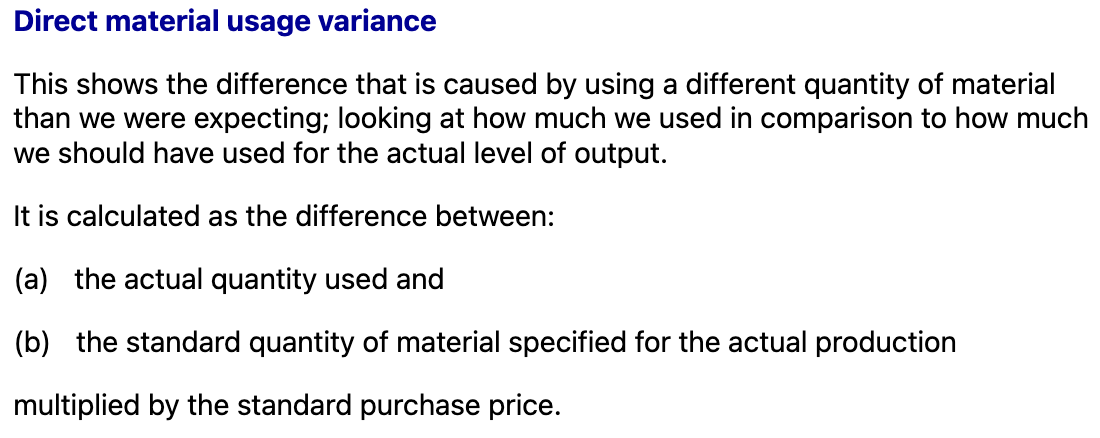
What are some potential causes of material price variances?
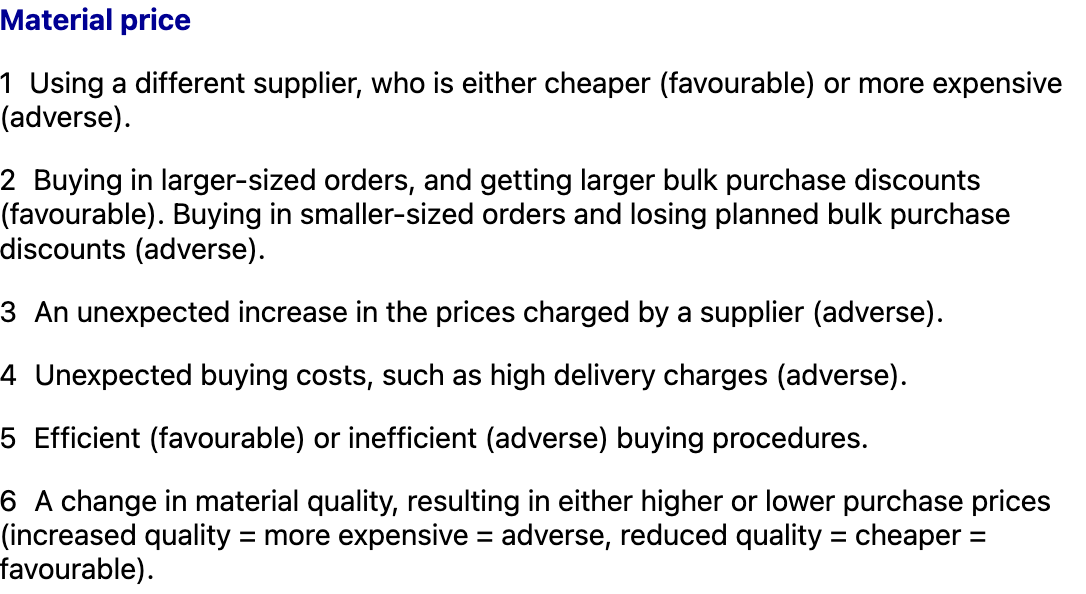
What are some potential causes of material usage variances?
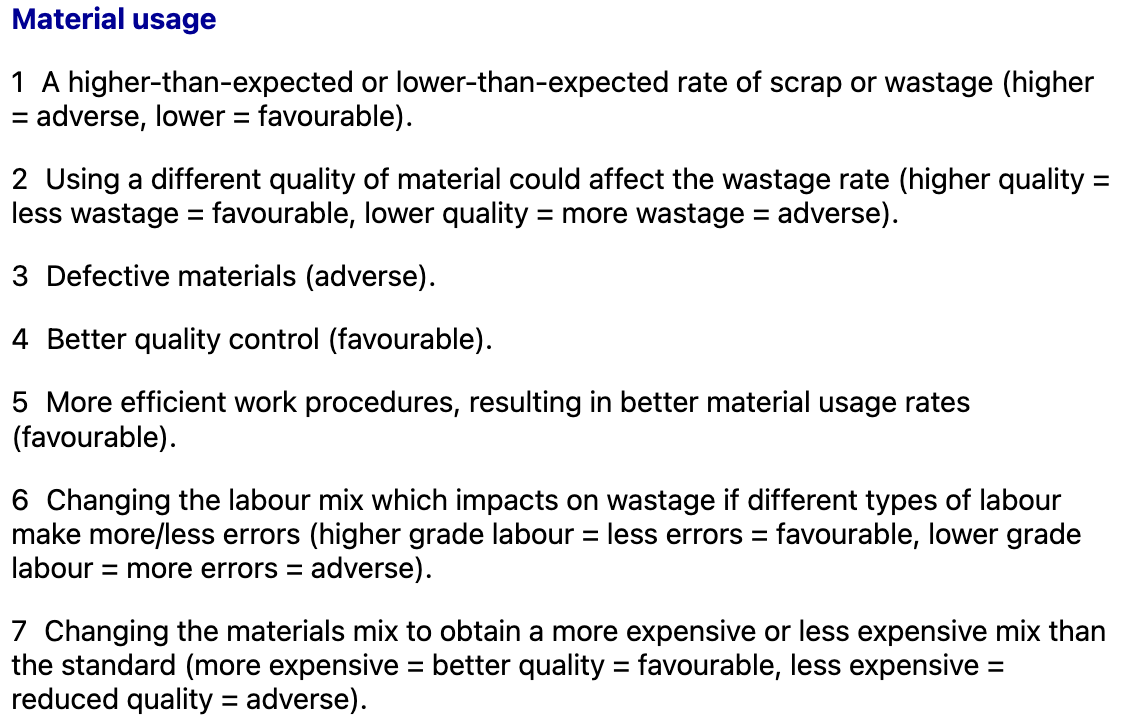
Direct labour total variance is the difference between:
the actual cost of direct labour and
the standard direct labour cost of the actual production.
A total labour variance can also be analysed further. It can be analysed into the following sub-variances:
Direct labour rate variance
Direct labour efficiency variance
Define them
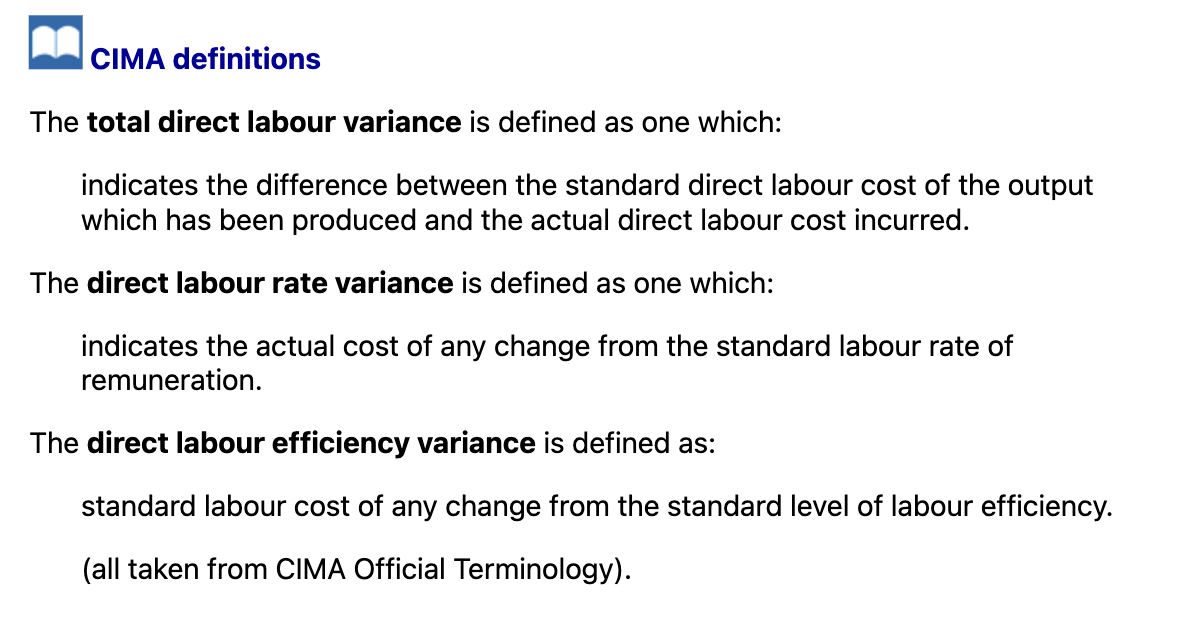
What happens to labour efficiency variance when idle time occurs?
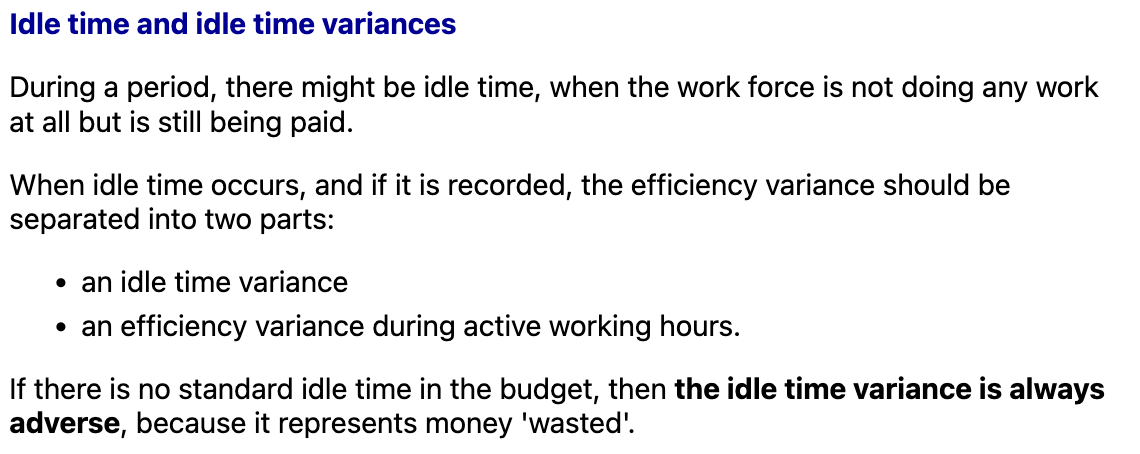
how is the direct labour idle time variance defined?
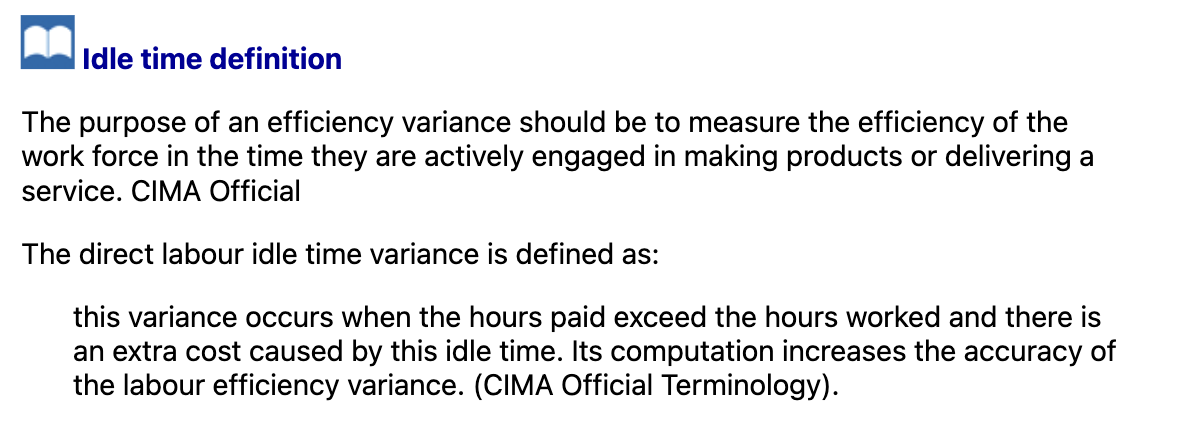
How is the idle time variance calculation different if an organisation experiences idle time on a regular basis?
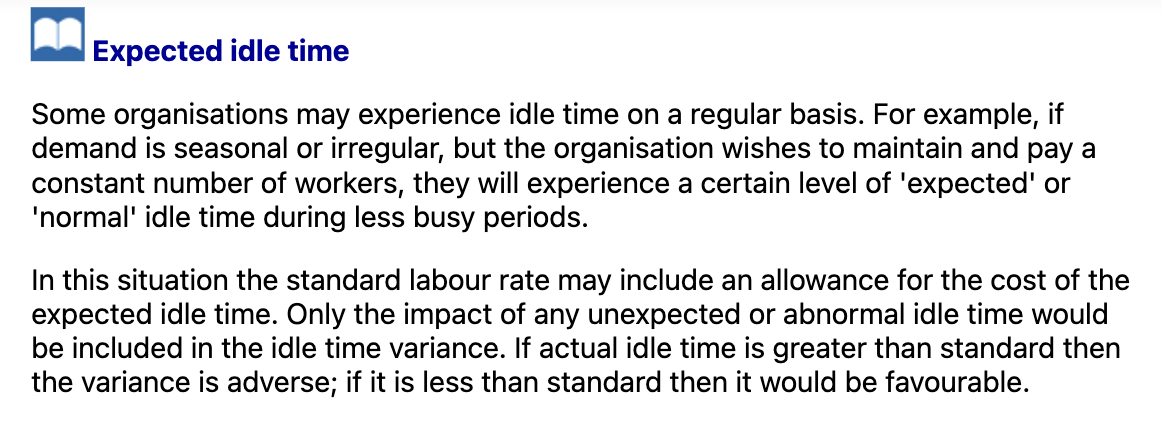
What are some of the possible causes of labour rate variances?
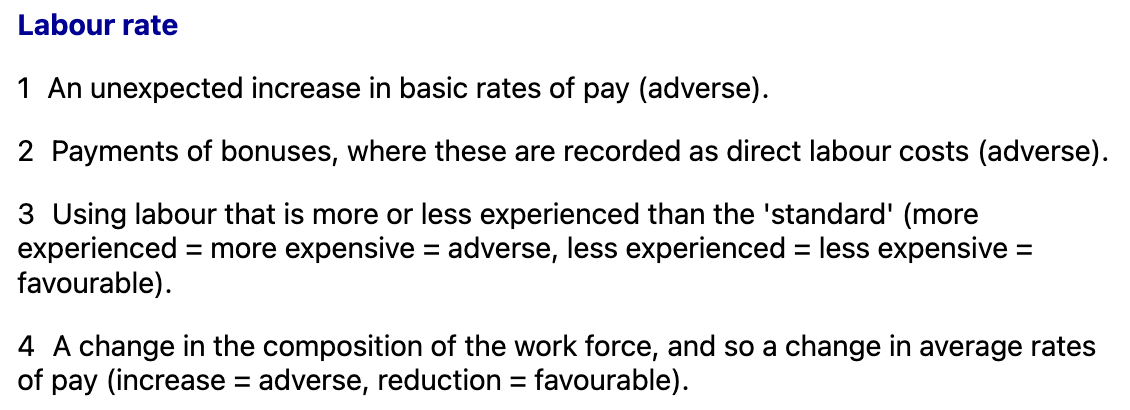
What are some of the possible causes of labour efficiency variances?
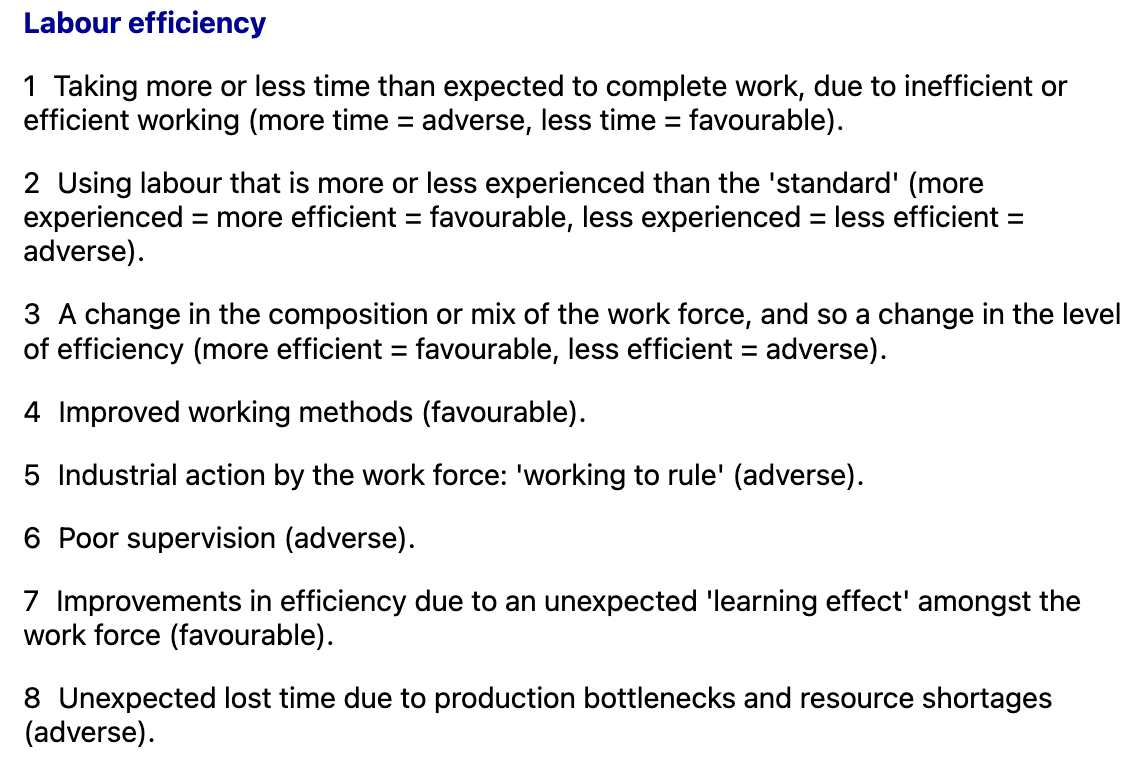
Define the following:
variable production overhead total variance
variable production overhead expenditure variance
variable production overhead efficiency variance
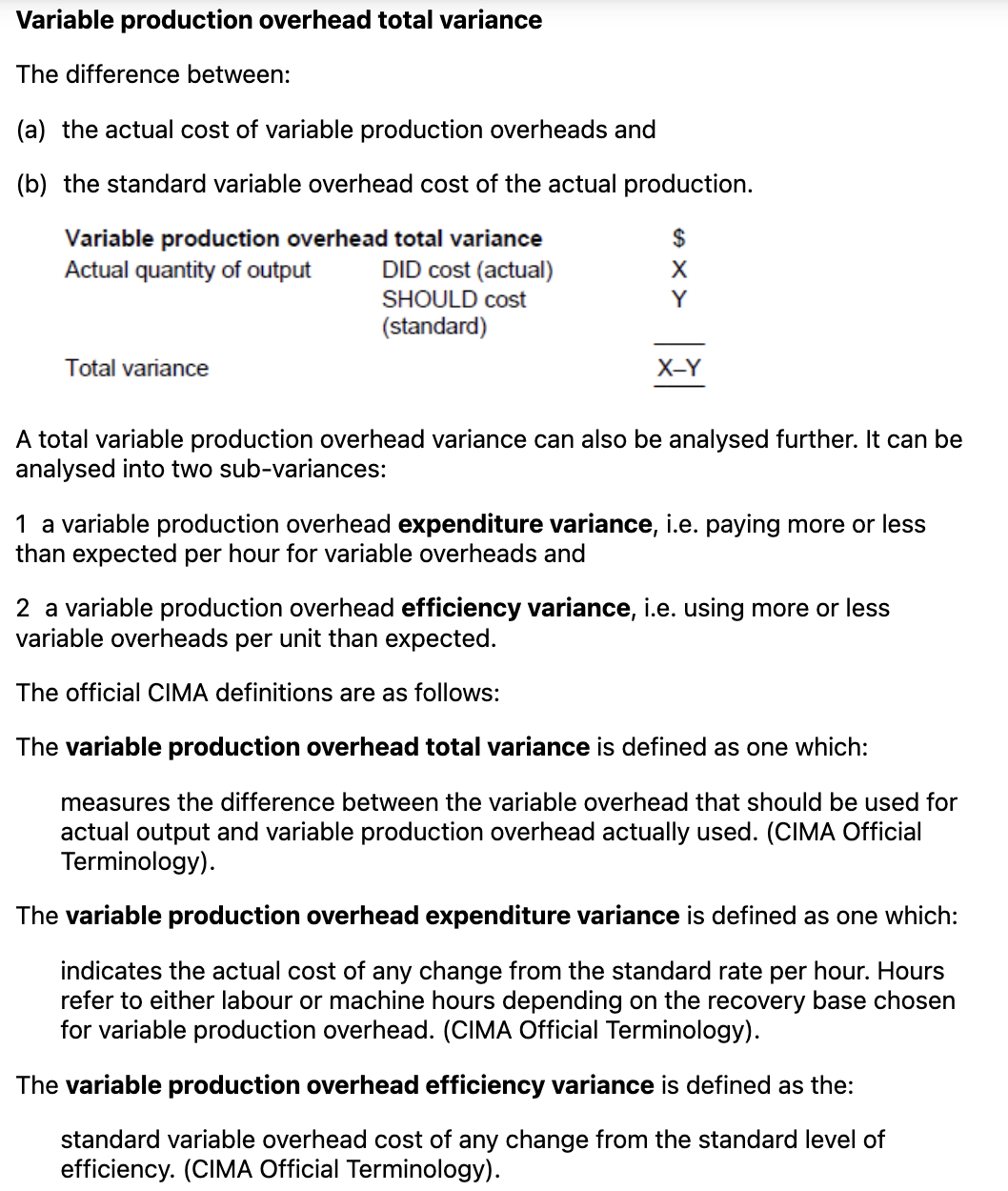
What is assumed with variable production overhead variances?
What the sentence means
Variable production overhead (VOH) (power, small supplies, etc.) only happens when machines/people are actually working.
Idle time = hours paid but no production (breakdowns, no materials, etc.).
So, when we analyse VOH variances, we should treat VOH as incurred on active hours only, not on idle hours.
Why this matters: if you include idle hours in the VOH calculations, you’ll create fake “inefficiency” in overheads, even though nothing was being used.
Quick example
Standard VOH rate (SR) = $3 per hour
Standard hours for the output (SH) = 100 hours
Actual hours paid = 110 hours, of which 10 are idle → active hours = 100
Actual VOH rate (AR) = $3.20 per active hour
Actual VOH cost = 100 × $3.20 = $320
Correct (active-hours-only) treatment
VOH spending (expenditure) variance
= (AR − SR) × Active hours
= (3.20 − 3.00) × 100 = $20 AVOH efficiency variance
= SR × (Active hours − SH)
= 3.00 × (100 − 100) = $0
Idle time doesn’t show up in VOH variances (because no VOH should be incurred while idle). The cost of idle time is analysed in labour variances instead.
If you (wrongly) used total hours paid (110)
Spending variance = (3.20 − 3.00) × 110 = $22 A
Efficiency variance = 3.00 × (110 − 100) = $30 A
Now VOH looks “inefficient” by $30 just because there were 10 idle hours—even though VOH wasn’t used during that time. That’s misleading.
Bottom line
Assume VOH is driven by active production hours. Analyse idle time in labour variances, not VOH; otherwise you’ll blame overheads for time when nothing was running.

What is the variable production overhead expenditure variance the difference between?

Does the fixed production overheads variance occur in the marginal costing system?

What do fixed overhead capacity and efficiency variances measure?

What are some potential causes of fixed and variable overhead variances?
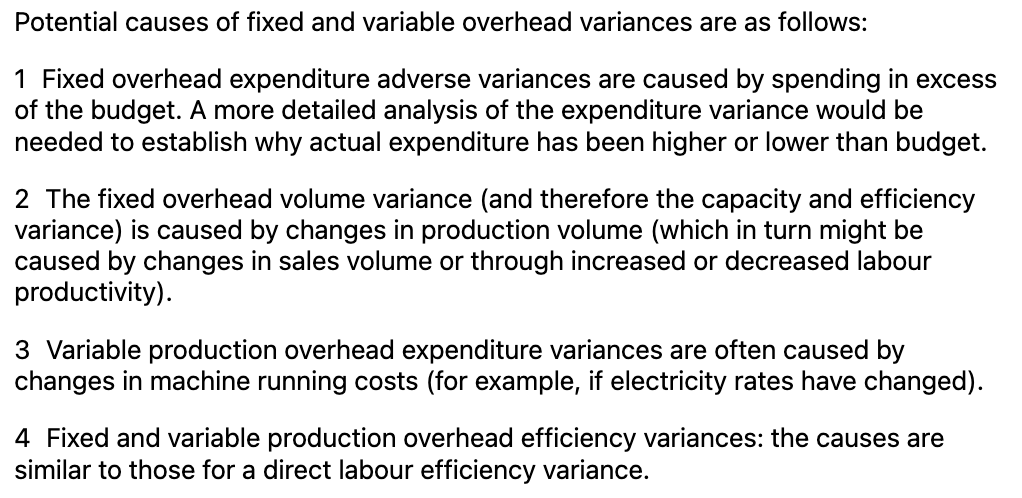
Explain interdependence between variances, give 1 or 2 examples.
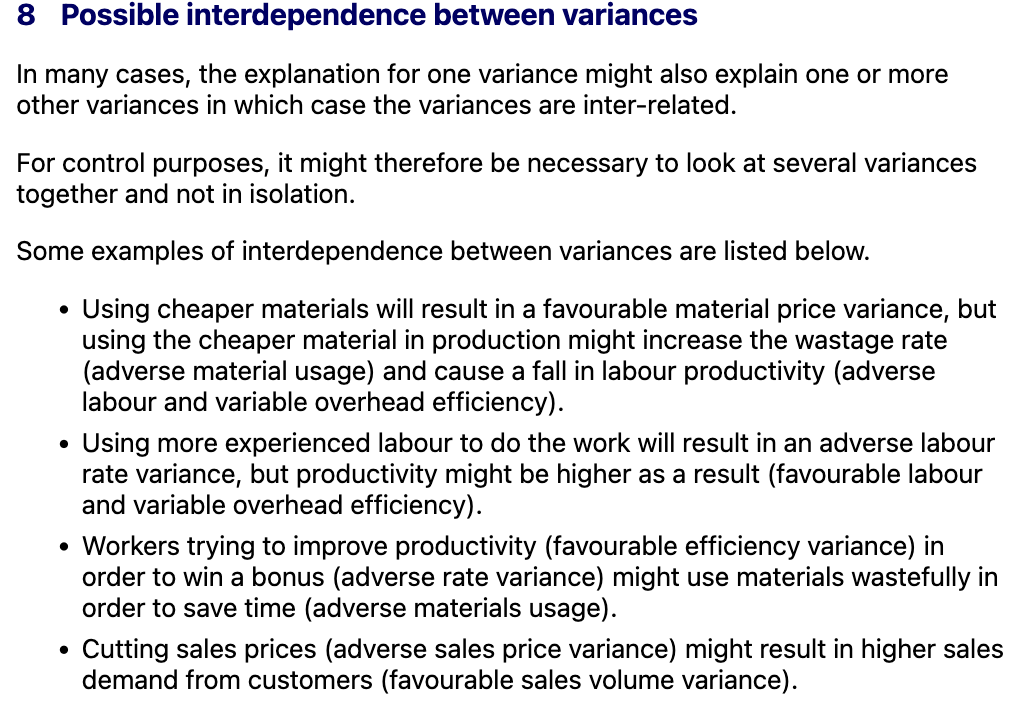
what is an operating statement?

How often should variances be reported and what may a typical hierarchy of control reports look like?
